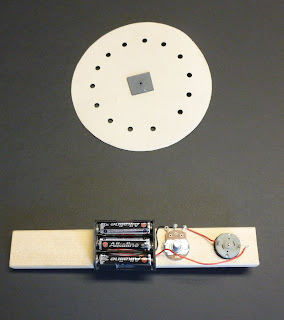Siren Disk
Materials:
• approx. 8'' 1x2'' wood
• card stock (about 8'' square) or a stiff paper plate
• 3 AA battery holder ( available from www.sciplus.com item # 92477)
• 2-5k potentiometer (available from online electronics suppliers)
• switch (optional)
• small dc motor (about 3/4'' dai.)
• 1/8'' vinal tubing x18'' (not shown)
Tools
• drill with bits that are near the size of your motor and optionally you potentiometer (we like Forstner bits for this application)
• hot glue gun
• hole punch
• scissors or a utility knife
• soldering iron (optional but will make the siren disk more reliable)
• compass
• saw
Make the disk
Use a compass to draw an approx. 7-8'' circle on you card stock or in the center of your paper plate. Cut the circle out and then add the holes (at least 10) with a hole punch. By pushing the paper into the punch as deep as it will go you will end up with a perfect circle of holes, while you don't want your holes to be bunched together its not a problem if they're not perfectly spaced around the disk. Finally, using a thumbtack mark the center of the disk, add another small piece of card stock on top and hot glue it down to reinforce the center hole.
Make the handle
Cut about 8'' of 1x2'' and drill a hole for your motor about 1'' from one end. If you have the right sized Forstner bits, drill out a pocket for you potentiometer, as it will be much more secure than just attaching it to the surface.
Add your components
Wrap the motor with a little tap until it will press fit into the hole at the top of the handle. Next hot glue the potentiometer into its pocket below the motor (if you didn't make a pocket be generous with the glue.) Scratch up the bottom of the battery holder with a nail and then glue it below the potentiometer. connect you components like so :
We ended up using, 3 AA batteries (4.5v) and a 5k potentiometer while this functioned, the control only worked at one end of the scale, going to a <5k potentiometer or using 4 AA batteries (6v) with a 5k potentiometer would probably make for smoother results (see this site for specifics on rheostats). Soldering the wires and adding a switch or an alligator clip to the circuit will make it more reliable and less likely to run itself out of power if you forget to disconnect it, but are not necessary.
Use it
Slowly turn up the power on the potentiometer while blowing through the vinyl tube and aiming at the ring of holes.
Things to do and notice
Blowing through the spinning disk acts like a valve alternatively letting air through and deflecting it, emitting pulses of air much like the reads of a straw oboe. The harder you blow and the closer the tube is to the disk the louder the sound will be. The speed of the disk, the number of holes passing the tube in a given amount of time determines the frequency of the sound waves and thus the pitch. The faster it turns the higher the pitch. The main difference between this and an instrument like a straw oboe and a siren disk is that the disk lacks a resonator. However, you can make one by holding a piece of pvc pipe (less than 6'') opposite the tube while blowing through it and changing the speed, the sound will get much louder when the resonant frequency is reached. You could also add a paper cone or the cut off top of a bottle as a horn and place it opposite the tube to make it louder. Adding a horn does not really function as a resonator but instead makes the air coming through the disk more efficiently transfer vibration to the surrounding environment as it does in a wind instrument.
The variations of siren disk mechanism can be found in things as small as party favors (siren whistles), and as large as air raid sirens, the main difference is the about the amount and pressure of the air being forced through the chopper disk or drum.




